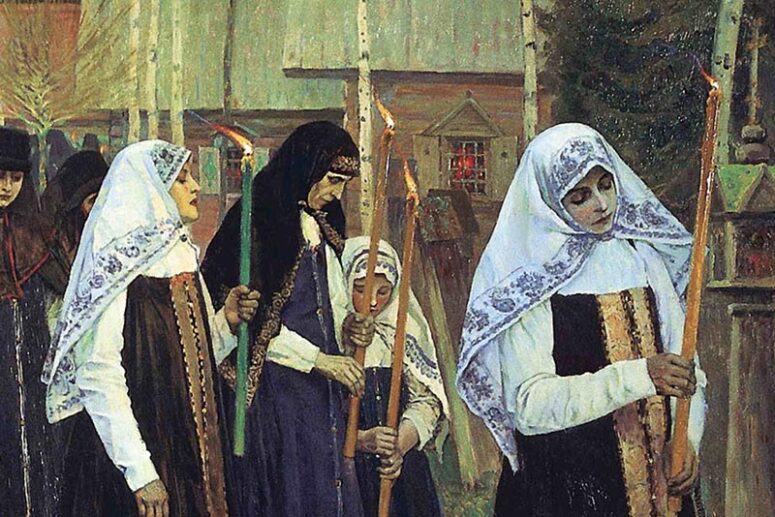
For 2000 years in the Orthodox Church, the tradition has been for women and girls to veil their heads during worship, whether at church for the liturgy, or at home for family prayer time.
What is the Scriptural and Patristic evidence for this tradition, and why is it important?
In this article, we will take a look at headcoverings in the Old Testament, headcoverings in the New Testament, headcoverings according to the early Church, headcoverings in icons, and headcoverings today. At the end of the article there are links to additional resources for learning about Christian headcoverings.
Headcoverings in the Old Testament
Centuries before the birth of Christ, women’s headcoverings were an accepted practice for God’s people. It was not merely an option for those who wished to be holy. Rather, it was a matter-of-fact expectation that all women would cover their heads.

When the Holy Spirit inspired Moses to pen the first five books of Scripture, women’s headcoverings were simply assumed to be the normal practice. In the book of Numbers, when a unique ceremony is performed that requires an uncovered head, Scripture makes a point to say that the woman’s headcovering needs to be removed:
“The priest shall stand the woman before the Lord, uncover the woman’s head, and put the offering for emembering in her hands.” (Numbers 5:18)
Of course, such a requirement would make little sense, if women did not normally keep their heads covered.
Even earlier than this, in the book of Genesis, we read about Rebekah, on a journey to meet her future husband, Isaac:
“Then Rebekah lifted her eyes, and when she saw Isaac she dismounted from her camel; for she had said to the servant, “Who is this man walking in the field to meet us?” The servant said, “It is my master.” So she took a veil and covered herself.” (Genesis 24:64-65)
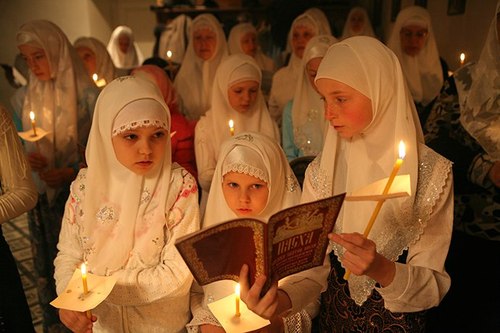
Her godly discretion is a model for women today. She did not flaunt her physical beauty. Rather, she veiled herself, increasing her allure through an outward display of modesty.
Women’s headcoverings can also be found in the story of Susanna. It is the captivating story of a beautiful, virtuous woman who was falsely accused, and later vindicated by the wisdom of young Daniel. Susanna wore a veil that covered not only her head, but her face as well. Scripture looks disapprovingly upon the removal of her veil:
“Now Susanna was exceeding delicate, and beautiful to behold. But those wicked men commanded that her face should be uncovered, (for she was covered,) that so at least they might be satisfied with her beauty. Therefore her friends and all her acquaintance wept.” (The Story of Susanna / Daniel 13:31-33)
In this passage of Scripture, virtuous people approve of women’s headcoverings and veils, while ungodly men seek their removal.
Headcoverings in the New Testament
Women’s headcoverings are one of the many points of similarity between Israel and the Church. Godly women had covered their heads for thousands of years prior to the advent of Christ. And when the New Testament Church was born, godly women continued the practice.
In St. Paul’s first epistle to the church in Corinth, he instructs everyone to follow the holy traditions which have been received:
“Now, I praise you, brethren, that you remember me in all things and keep the traditions just as I delivered them to you.” (1 Corinthians 11:2)
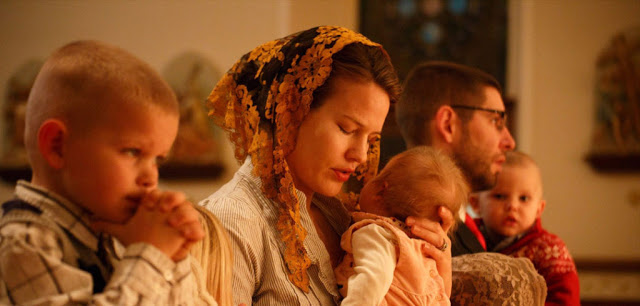
Women’s headcoverings are one of the holy traditions which the Church had received, and St. Paul spends the next several paragraphs discussing them. He says that headcoverings manifest honor, in the context of worship:
“Every man praying or prophesying, having his head covered, dishonors his head.” (1 Corinthians 11:4)
“Every woman who prays or prophesies with her head uncovered dishonors her head.” (1 Corinthians 11:5)
The message is pretty clear: It is honorable for a woman to wear headcoverings during worship, but it is dishonorable for men to wear them. This is why men remove their hats for prayer, even to this day.
Not content to make his point only once, St. Paul reiterates himself a few verses later. Women are to cover their heads, and men are not to do so:
“A man indeed ought not to cover his head, since he is the image and glory of God; but woman is the glory of man.” (1 Corinthians 11:7)
“The woman ought to have a symbol of authority on her head, because of the angels.” (1 Corinthians 11:10)
The Old Testament reveals that this holy tradition is ancient, but it only begins to hint at the reasons.
Here in the New Testament, we are given some reasons for the practice. According to 1 Corinthians 11, headcoverings manifest a woman’s honor. They also are important “because of the angels”.
Angels are present with us when we pray, and when we worship. While we may not fully understand why headcoverings are important to the angels, it is sufficient for us to know that this reason is given in Scripture. If Scripture says that women’s headcoverings are important to the angels, then it is something we should take seriously.
Headcoverings according to the Early Church Fathers
St. John Chrysostom (d. A.D. 407), in a sermon at the Feast of the Ascension, spoke both of angels and the veiling of women:
“The angels are present here… Open the eyes of faith and look upon this sight. For if the very air is filled with angels, how much more so the Church!… Hear the Apostle teaching this, when he bids the women to cover their heads with a veil because of the presence of the angels.”
Origen, another prominent teacher in the early Church, said,
“There are angels in the midst of our assembly… we have here a twofold Church, one of men, the other of angels… And since there are angels present… women, when they pray, are ordered to have a covering upon their heads because of those angels. They assist the saints and rejoice in the Church.”
The Apostolic Tradition was written in the second century, and the author is believed to be St. Hippolytus of Rome. This book has instructions for catechumens, including this:
“And let all the women have their heads covered with an opaque cloth… “
And St. Cyril of Alexandria, commenting on First Corinthians, wrote:
“The angels find it extremely hard to bear if this law [that women cover their heads] is disregarded.”
Headcoverings in Icons
Icons in the Orthodox Church are a visual guide to the Faith, a sort of “picturebook” of Christianity. Icons teach us about the life, death, and resurrection of Christ, and about the lives of many Christians who have gone before us.
Icons also teach us about headcoverings.
Virtually every icon of an Orthodox woman displays her wearing a headcovering. As far as I know, the only exception is St. Mary of Egypt, and she was a solitary saint who lived alone in the desert, far away from any people.
Among the female saints who participated in society, all of them wore headcoverings, and their headcoverings are shown in icons.
Even Mary the Mother of God–the most blessed woman in the entire universe–is shown in icons, wearing a headcovering.
Can you think of a better role-model for women?
Headcoverings Today
In our church, all women and girls are asked to wear headcoverings, in obedience to God’s command in Scripture, and out of respect for the holy traditions of the Orthodox Church. Just inside the front door of the church, we keep a basket of headcoverings, just in case a woman forgets hers at home and needs to borrow one for the day. Headcoverings are also worn at home, during family prayer time.
While honoring God’s direction is a reward unto itself, there are many other benefits as well. For example: Headcoverings manifest a woman’s honor. As St. Paul points out in Scripture, a woman brings honor to herself by covering her head during prayer.
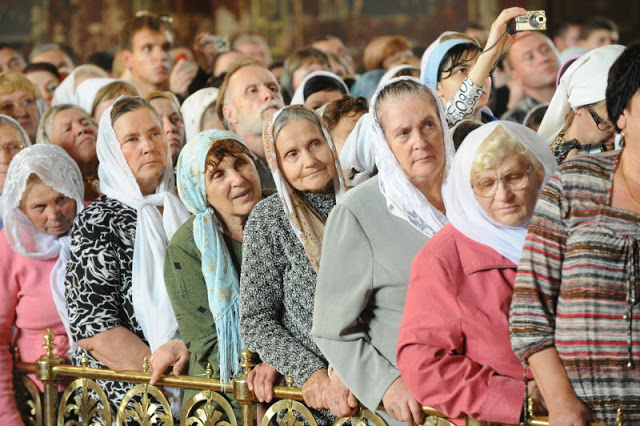
Headcoverings encourage humility. Godly women come to church to focus on worship, not to draw attention to themselves. A girl may be tempted to show off an attractive hairdo. When a woman wears a headcovering, this temptation is removed. She can focus on prayer, instead of on hair.
Headcoverings save time. In today’s culture, it can be tempting to spend a lot of time and energy on hairstyles. But headcoverings are quick and easy. It takes a lot less time to put on a headcovering, than it does to prepare a hairdo for display.
Headcoverings help us show love and consideration for our brothers. Godly men come to church to focus on worship. But the flowing locks of beautiful woman can be distracting. By veiling her hair, a woman can display her modesty, and remove an unnecessary distraction.
A mainstream theological journal recently published an article about women’s headcoverings. Soon after, the author of the article became a member of the Orthodox Church. In the article, she beautifully illustrates the iconic purpose of headcoverings:
“My wearing a head covering is not only a symbol or sign that I am in agreement with His order, but that I visibly,
willingly submit to it. With submission comes blessing.” (Christa Conrad)
willingly submit to it. With submission comes blessing.” (Christa Conrad)
In an issue of The Handmaiden, a lady named Elizabet gives her testimony about wearing headcoverings:
“For twelve years I have worn a scarf [headcovering] at all times. I now perceive that it has been—and continues to
be—essential for the pilgrim journey and salvation of my soul. The bottom line for me—and a growing number of my sisters—remains obedience. And with it comes a sense of being in our rightful place in God’s ordered universe, rejoicing with the angels. Now I gratefully say, “I am!” in the presence of the great I AM—at prayer and in church, surrounded by the angelic host, worshipping our Lord and King. To God, Father, Son, and Holy Spirit, be the glory, now and ever and unto ages of ages. Amen!”
be—essential for the pilgrim journey and salvation of my soul. The bottom line for me—and a growing number of my sisters—remains obedience. And with it comes a sense of being in our rightful place in God’s ordered universe, rejoicing with the angels. Now I gratefully say, “I am!” in the presence of the great I AM—at prayer and in church, surrounded by the angelic host, worshipping our Lord and King. To God, Father, Son, and Holy Spirit, be the glory, now and ever and unto ages of ages. Amen!”



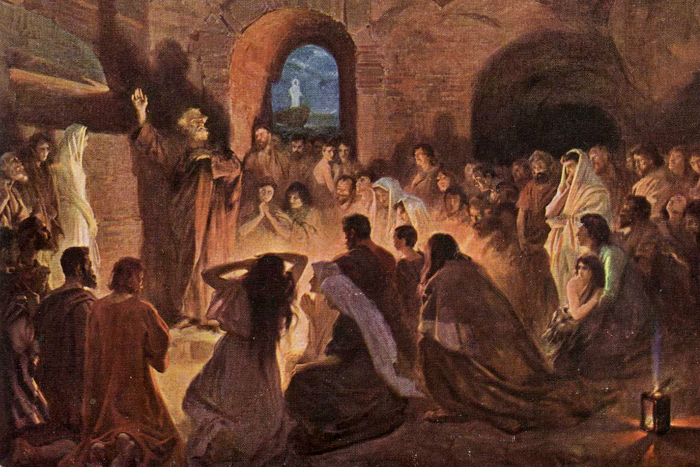
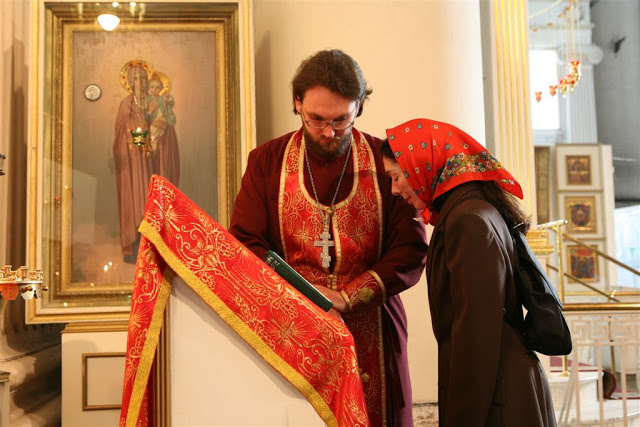
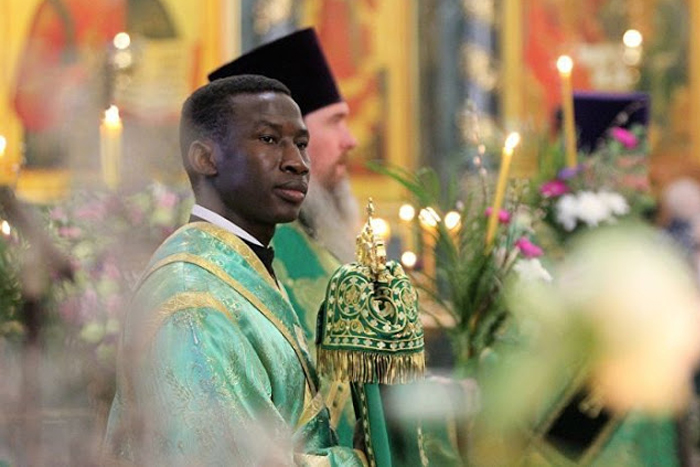
I believe that Paul is responding to a faction of men who wrote him in 1 Corinthians 11:4-6. Scholars know that Paul quotes throughout his first letter to those in Corinth and he always includes their words so that the people he is writing to know which part of their letter he is addressing.
Also, men say that they are the image and glory of God. However, the Bible is clear that Jesus Christ is the image and glory of God (2 Cor. 4:4, Col. 1:15, John 1:14, Heb. 1:3, Rev. 21:23). There is no place in Scripture that says that a man is the image of God or the glory of God. The Bible does say that male and female are created in God’s image. But being created in the image of God is not the same thing as being the image of God. Jesus Christ is the Word made flesh. Therefore, He is the visible image of the invisible God. As Jesus said to his disciple Philip, “Anyone who has seen Me has seen the Father” (John 14:9).
Also, in the men’s argument (vv. 4-6) you can clearly see that they are making a LITERAL head argument. They are saying that “Every man who has anything down over his head while praying or prophesying disgraces his [own] head. But every woman who has her head unveiled while praying or prophesying disgraces her [own] head. We know that they are making a literal head argument because they then compare a woman praying and prophesying unveiled to a woman whose head is shaved. If these were Paul’s words, and he was saying that a woman disgraces her figurative head, her husband, then he would have given a correlating example of how she would disgrace her husband, e.g. — it is one and the same thing as correcting him in public. Verse six even says, “…but if it is disgraceful FOR A WOMAN to have her hair cut off or to be shaved, let her be veiled.” The text does not say, “…but if it is disgraceful to the husband for a woman to have her hair cut off or to be shaved, let her be veiled.” So a LITERAL head argument is being made in verses 4-6.
Because the men made a literal head argument, Paul gives his model (v. 3) with the figurative meaning of head, which means “source/origin”. He then gives his rebuttal (vv. 7-16), where he refers back to his model (v. 3) to explain exactly why women are not to be veiled. In verse seven he writes, “For a man indeed ought not to veil his head [Jesus Christ], since He is the image and glory of God, but the woman is the glory of man.” So Paul is trying to get the men to understand that just as a man ought not to veil his head, Jesus Christ, because Jesus Christ is the image and glory of God, so also the man ought not to veil the woman because she is his glory. And Paul’s teaching is in harmony with Christ’s teaching when Christ said to believers, “You are the light of the world. A city on a hill cannot be hidden; nor does anyone light a lamp and put it under a basket, but on the lampstand, and it gives light to all who are in the house.”
So Paul is actually refuting their argument. Unfortunately, Bible translators have made verses 13-15 into questions. But Paul is actually making statements. He is saying, 13″Judge for yourselves that it is proper for a woman to pray to God unveiled. (Note: The Greek word “estin” means “it is”.) He then says, 14″Or not even nature itself teaches you that if a man has long hair, it is a dishonor to him, 15but if a woman has long hair, it is a glory to her because the long hair has been given instead of a covering.” (Note: The disjunctive particle at the beginning of verse 14 does not mean “does”. In fact, this disjunctive particle appears 341 times in the New Testament and it is translated as “does” only one time, in 1 Corinthians 11:14. It’s true meaning is “or, than, and, either” with its most common meaning being “or”.) So Paul is saying that nature does not teach you that if a man has long hair it is a dishonor to him because God has allowed it through nature. This is why it was not a disgrace for men to have long hair—e.g. – Samson, Samuel). If God did not want men to grow long hair then he would have disallowed it through nature just as He has disallowed women to grow mustaches or beards through nature. Paul is also saying that nature does not teach us that if a woman has long hair it is a glory to her as many women have unmanageable hair, (thin, prone to breakage, dry, frizzy). So Paul is saying that both men and women can grow their hair long or cut their hair short.
Unfortunately, through the centuries, men wanted women to be veiled and to be silent in any type of religious gathering. But Paul addresses these men and also the faction of men who wanted women to be silent in the churches (1 Corinthians 14:34-35). Paul knows that there are factions among them (1 Corinthians 11:19) which is why he includes their words whenever he addresses them. Paul was a big defender of women and made clear that there is neither male, nor female, in Christ (Gal. 3:28).
Clement of Alexandria (195 bC) teach to womens to wear veils outside their houses, and pray with the veil. Tertulian (197 bC) says a lot about this topic. These people speak, read and write greek. It seems strange that they are misunderstanding Paul letter.
The Moslems make the same arguments; why don’t Orthodox women wear Burqas too? Or just simply stay at home and pray the way Moslem women are encouraged to do? Men getting excited over seeing female hair? Why isn’t he called about his problem? But I understand it- the goal is to get people to submit to Iron Age culture and beliefs and to ignore that we at present live in the 21st century. Well, you’re free to go your own way it’s just wrong to condemn others who believe in a modern Christianity.
Veils were in the bible before they were in the quran, christian women have been veiled for centuries, and don’t compare us to muslims, WE ARE NOT THE SAME. the bible says that women need to cover their hair while praying, as a christian you should follow.
Youre essentially arguing here that we should submit to changeable culture, not to gods guidance which is unchanging. I suggest trying a head covering before calling it oppressive – as a woman I tried it with an open mind a few months ago and not only felt more beautiful, but closer to god. I don’t judge women who don’t like to do it, but I think every woman should give it a chance before ruling it out.
Christian head covering is different from Islamic covering. Christian head covering points to the subjection of all women to all men and to her ontological inferiority. In Islam, it is a matter of modesty. Some Muslim commentators actually point out that since women are considered such inferior creatures in Christianity (literally unfit to stand uncovered in the presence of God unlike men) they are better off in Islam.
Islam does tell women to cover their entire bodies including hair while praying, and it does say that men are permitted to control women’s lives. I’ve been in both religions and find Christianity a lot more liberating. Wearing a head covering doesn’t say that women are less than men, just that they should accept they are not the leaders in churches as only men are permitted to lead in church.
Thank you for the insightful article. I appreciated it and found it to be uplifting, thought-provoking, and convicting. It seems a few other women felt the conviction as well but instead of pondering on that and praying about it, they lashed out in the comments. Let us all keep those sisters in our prayers!
God bless you Fr Gleason for this article. Why do people want to nitpick scriptural verses in criticism as do protestants? We gain wisdom from Scripture, but we should not discount 2000yr of Holy Tradition. When I cover my head I’m also reminded of God’s Order in the cosmos – I have a Christian marriage with Christian vows (made in a church) reflecting a Christian relationship between husband and wife, and not a secular union promised in a rose garden. Another interesting Ikon is Christ with the Samaritan woman at the well – she’s shown with bare head and/or bare arms indicating her irregular life. Lord Jesus Christ Son of God have mercy on me a sinner.
I am an Orthodox Christian woman and I do veil in church and at home during a lot of my formal prayers. But I don’t do it because being unveiled is a “distraction to men” as if men have no control over themselves and no accountability to God for their own impure thoughts. Yes you mentioned women but historically its always about the “weakness of men” and the women who are scandalized because they also believe men are so weak.
I cover “because of the angels” and because our hair is our God given glory and I dont want to take away from the glory of God when I’m praying, regardless of whether there are people around. When I pray at home alone, I still veil, again, because of the angels and because veiling is a reflection of the *dignity* God gave to women.
What I do find interesting is that on the one hand you are telling women to dress modestly because otherwise they are a distraction, and they should veil because its Holy Tradition. You then go on to describe what an Orthodox man wants in a woman and what attracts not just his attention, but his *approval*, which is that she is modestly dressed and is veiled. And at the same time you are telling women they shouldn’t want a man that judges her by her appearance!
That’s the problem with making “distraction” and “appearance” the reasons for veiling.
Women in church shouldn’t be trying to attract *anyone*. That’s not what we are there for. Im married, I have no need to attract someone!! Dress8ng modestly amd veiling just to “appear more pious” (to attract a pious man) is just as much a problem as dressing immodestly to attract a man.